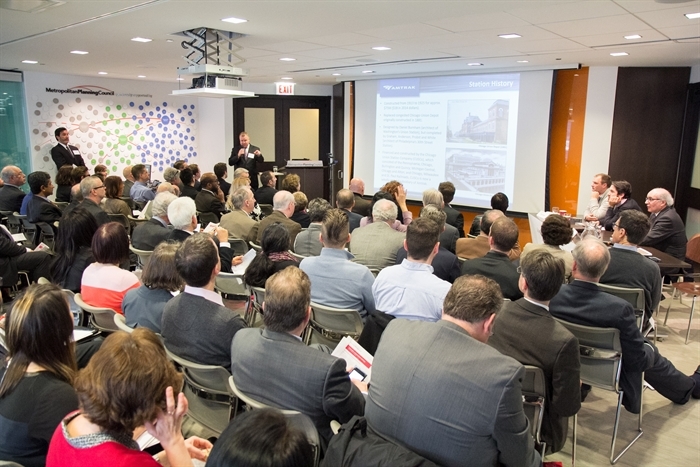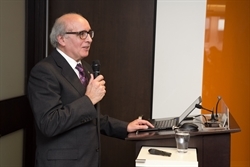
Opening up the concourse to improve flow is one of the ways Amtrak is planning to renovate Union Station.
The Metropolitan Planning Council (MPC) has long envisioned Chicago Union Station as more than a train terminal: It can be renovated and reinvigorated as a destination and a catalyst for growth in the West Loop, the city and the region as a whole.
On Tuesday, Feb. 16, we held a roundtable with local and international experts to talk about the latest developments at Union Station and the next steps for realizing this vision. The architect leading the ambitious renovation of Toronto’s Union Station—remarkably similar to our own station—shared his experience, and a local real estate developer and a restaurateur talked about the great potential they saw in the space. Amtrak is seeking a master developer to lead the reinvention of the station, and our panel of experts indicated this was the right way to proceed.
MPC Executive Vice President Peter Skosey kicked off the discussion with a brief history of MPC’s interest in the station. In 2011, we were invited to chair an advisory committee and shape a master plan for the station. Peter found that becoming familiar with the grand and historic vacant spaces in the station had an intoxicating effect: Once you’ve seen them, you’ll never forget them, and never stop thinking about their potential. These spaces once housed restaurants, lounges and other services for passengers traveling across the country by train. Including the eight-story office tower above the Great Hall, Union Station contains more than 700,000 square feet of vacant commercial space.

Amtrak's Ray Lang speaks to a full house in MPC's conference center.
Amtrak’s Ray Lang is leading the renovation of Chicago Union Station. He told us about the station’s rich history, and that the current layout is the result of jet-age thinking that assumed train travel was on the way out. The passenger concourse can’t handle the 120,000 (and growing) Metra and Amtrak passengers that use it every day, so widening platforms, improving flow and adding waiting space are short-term priorities in the master plan. Amtrak estimates these initial renovations will cost about $200 million. To raise that funding, MPC has introduced legislation in Springfield that would allow the City of Chicago to dedicate revenue from increased land values around the station that would result from any improvements to the station.

Silvio Baldassarra, president of NORR Canada, is leading the renovation of Toronto Union Station.
Revenue from leasing vacant space would also help pay for the needed renovations to the station. Silvio Baldassarra, president of NORR Canada, took the podium next to share how he’s leading the renovation of Toronto Union Station.
Like Chicago’s station, Toronto's is an imposing Beaux-Arts structure that was originally designed to serve long-distance passengers but now sees the bulk of its traffic from commuters. It too suffered from a constrained passenger concourse and years of neglect. In fact, it almost met the same fate as New York’s Penn Station. A 1970s proposal would have demolished the historic building and put a convention center and office towers over the tracks.

Raysonho (Wikipedia)
The Great Hall of Toronto's Union Station.
Work is currently underway to expand the Toronto station’s passenger concourse and enhance flow while restoring the building’s appearance. The most ambitious part of the renovation will add 118,000 square feet of retail space by digging down and adding a new level under the existing concourse. Amazingly, all of this excavation and structural work is happening without disrupting any of the train operations above.
NORR and the City of Toronto looked at New York’s Grand Central Terminal as a model: Beneath its famous concourse is a bustling dining and retail level. People go to Grand Central to eat, drink and shop even if they’re not catching a train. Toronto counts on revenue from leasing these new commercial spaces to pay off the renovation costs, and Amtrak looks to do the same in Chicago.
To hear about the potential for retail and dining in Chicago Union Station, we invited real estate developer Jeff Shapack of Shapack Partners and restaurateur Chris Bisaillon of Bottleneck Mangement to share their thoughts. Jeff has developed extensively in the Fulton Market district, and his portfolio includes Soho House and WeWork. Chris’ company owns Howells & Hood in the historic Tribune tower, and South Branch Tavern Grille, which is right across the river from Union Station.
Both men echoed Peter’s feeling that the potential of Union Station is intoxicating, but tempered that enthusiasm with the recognition that there is an enormous amount of work to be done. Any individual new restaurant or retail tenant at Union Station could not work alone; a master developer needs to take charge of all the real estate opportunities at the station to ensure that everything can work as part of a cohesive plan. Amtrak recently issued a Request for Information as a first step in identifying a master developer.

Real estate developer Jeff Shapack shares his thoughts about Union Station's potential.
Jeff offered the bold suggestion that all the dining options at Union Station, currently packed into a mezzanine level above the passenger concourse, be torn out and moved into the spaces around the Great Hall. This would open up space for circulation and waiting areas in the concourse and encourage better use of the Great Hall. He offered the Ferry Building in San Francisco as an example of a successful renovation and revitalization that relied on adding retail and dining. He also suggested that the station consider corporate branding opportunities, pointing to the United Center as a successful naming rights deal for both the airline and the stadium owners. Finally, as someone who drives in the city every day because of the nature of his job, Jeff encouraged the City of Chicago to consider congestion pricing on downtown freeway ramps as a way to control traffic and raise revenue for Union Station and improving transit service.
Pointing to his experience at Howells & Hood, Chris pointed out that pedestrian traffic is key. In the summer, when people are hanging out or passing through the adjacent plaza, the restaurant is packed. In winter, pedestrians tend to take more direct routes and the restaurant gets less business. Most Union Station passengers today bypass the Great Hall by entering above the concourse and heading directly to their train. Renovations need to make the Great Hall more accessible and open to the surrounding streets and to the train concourse, and create a draw or reason to go there. These sorts of big changes can’t happen piecemeal. They only make sense under a master developer arrangement. Chris also suggested the station would be better served by looking to local restaurants and chefs rather than national chains.
Exciting times are ahead for Chicago Union Station. The potential to be unlocked in renovating the station is vast, but overcoming the challenges in the historic space will require a master developer with a cohesive vision. Once fully activated, Union Station will be both a transportation asset and a destination itself to anchor a growing West Loop and a thriving region.
MPC thanks NORR for sponsoring this event.
